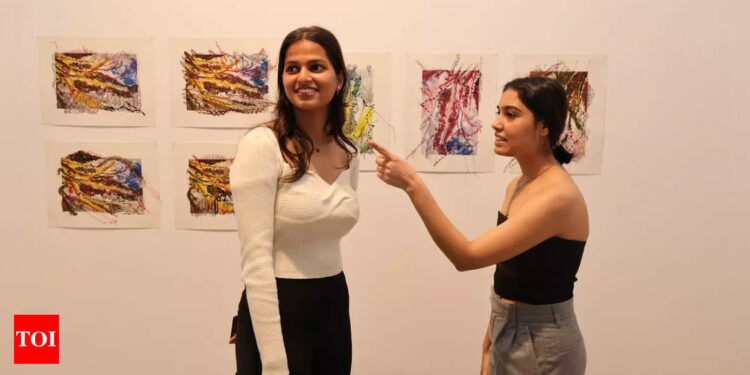A Deep Dive into Art: Identity, Ecology, and Feminism at the He/Hem Exhibition
Art as a Medium for Exploration
Recently, an eclectic group of art lovers converged at a contemporary art hub in Koregaon Park. They were welcomed by an innovative exhibition that ventured beyond mere visuals to intimately probe themes of identity, environmentalism, and feminism. Hosted by Vida Heydari Contemporary (VHC), this unique event showcased the collective efforts of six forward-thinking artists who defied conventional artistic boundaries through their use of embroidery on non-traditional surfaces.
Embroidery: Threads Connecting Nature and Emotions
Among the exhibiting artists was Aparajita Jain Mahajan—renowned for her multimedia approach—who harnessed embroidery to reflect on concepts like disruption and continuity within nature. “My creative journey revolves around imprinting emotions onto handmade paper through stitches,” she expressed. ”Exploring various media enables me to weave more intricate narratives.” Her work resonates with the ethos of Kanan Koteshwar, another featured artist who focuses on restoration amidst neglect. “By repurposing discarded items into my art,” Kanan shared, “I evoke poetic irony in rejuvenating what society overlooks.” His exhibit included botanical prints intertwined with threads that told poignant stories.
!environmental degradation. Artists use sustainable materials and engage with nature to convey powerful messages about the interdependence of life forms on our planet.
3. Feminism as a Lens
Feminist art pieces in the exhibit critique societal norms and advocate for women’s rights. By examining the historical context and current struggles, these works inspire conversations on gender equality, empowerment, and activism.
Featured Artists and Their Works
| Artist | Country | Featured Work | Theme |
|---|---|---|---|
| Ava Chen | USA | Reflections of Self | Identity |
| Jin Seo | South Korea | Rivers in Chaos | Ecology |
| Fatima Elhamdi | Morocco | Voices Unheard | Feminism |
| Maria Guarino | Italy | Interconnected Lives | All Three Themes |
First-Hand Experiences: Visitor Testimonials
The impact of the exhibit resonates with visitors, many of whom share their transformative experiences:
“This exhibit opened my eyes to the complex layers of my identity. I never realized how art could evoke such deep emotions!” - Sarah M.
“The environmental art installations moved me to take action in my own community. It’s a wake-up call!” - Lucas T.
“As a feminist, seeing how artists express these themes through various mediums was empowering. I felt inspired!” – Jessica R.
Benefits of Attending the Exhibit
- Inspiration: Engage with thought-provoking art that inspires personal reflection.
- Education: Learn about the historical and contemporary issues that intersect with art, identity, ecology, and feminism.
- Connection: Meet like-minded individuals who share an interest in these important topics.
- Empowerment: Leave feeling motivated to pursue change in your own community.
Practical Tips for Visitors
Make the most of your visit to this innovative exhibit with these practical tips:
- Plan Ahead: Reserve your tickets online to avoid long lines and ensure entry on your preferred date.
- Engage with the Art: Take your time to reflect on each piece, considering how it relates to your own experiences.
- Participate in Workshops: Sign up for accompanying workshops to deepen your understanding of the themes discussed.
- Join Guided Tours: Enhance your visit with insights from knowledgeable guides.
Case Studies on Influential Artists
This exhibit features influential artists whose works encapsulate the themes of identity, ecology, and feminism. Here are some case studies that highlight their impactful contributions:
Case Study: Ava Chen
Ava Chen’s Reflections of Self combines video installations and interactive elements that ask viewers to engage with their own identity. By emphasizing personal stories from various backgrounds, her work fosters a dialogue about the identities we curate.
Case Study: Jin Seo
Jin Seo’s Rivers in Chaos features a powerful installation made from recycled materials that represent polluted rivers. Her work speaks to the urgency of ecological preservation and invites viewers to contemplate their role in the environmental crisis.
Case Study: Fatima Elhamdi
In Voices Unheard, Fatima Elhamdi uses textile art to tell the stories of women from marginalized communities. Her piece evokes a sense of solidarity among women, emphasizing the struggles and victories inherent in the feminist movement.
Conclusion
By blending the powerful themes of identity, ecology, and feminism, this exhibit fosters a profound dialogue around pressing societal issues. Engaging with art in this space allows individuals to connect emotionally and intellectually, making it a must-visit for anyone passionate about social change through creative expression.
(Image credit: Shashank Sane)
Gender Resilience Meets Environmental Advocacy
Highlighting gender-related issues was artist Mayuri Chari whose works boldly confront societal norms while honoring female strength. Simultaneously, Debasree Das tackled pressing ecological dilemmas through her embroidered pieces which underscored the inseparable link between gender dynamics and environmental challenges faced today.
In addition to these powerful themes represented by Mayuri and Debasree, Varanasi-based Anshu Singh contributed a narrative focused on identity interwoven with cultural heritage through her paper embroideries. Moreover, Monali Meher—a multidisciplinary creator—investigated the intersections of time and memory via site-specific installations complemented by performative elements.
This enriching exhibition not only showcased diverse artistic expressions but also served as a reminder of how artistry can challenge preconceptions while knitting together critical discussions about our world today. With such powerful dialogues delivered through fabric and thread, “He/Hem” illustrates how contemporary art stands at the forefront not just in aesthetic appreciation but also in championing vital social themes.










